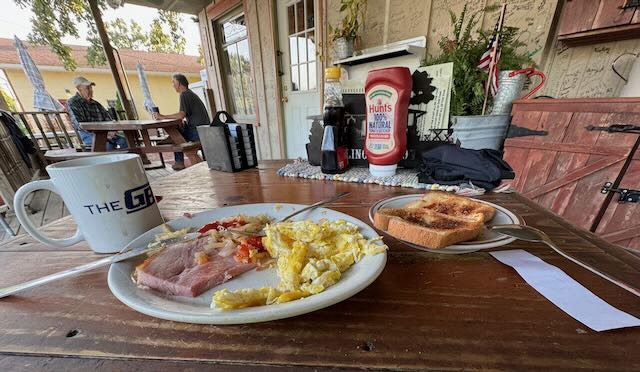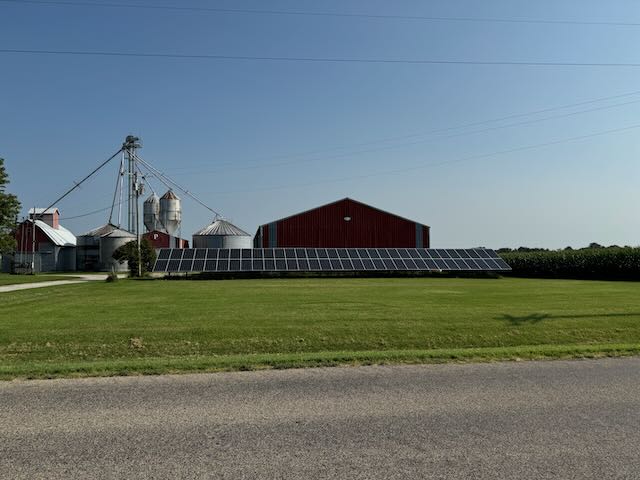Day 45. Wenona
74 miles 1,729 feet
The B&B was sold and not set up for breakfast but made arrangements for me to eat at the Filling Station nearby. It was open when I arrived at 6:45. There were several older men drinking coffee, as is typical, and they asked about my ride. I asked them about the wind turbine project and they were skeptical and somewhat critical of it. As I left town I took pictures of turbines at a corner and saw a line of pickups taking turns turning left. This scene signifies what we are facing: Lots of wind turbines being installed in a region culturally and economically tied to gas vehicles. It's complex but that is one of the barriers to adopting alternatives to oil.
The morning ride was flat and there was a 7 mph tailwind so I made good time. It was beautiful. The scene was green with patterns of corn and alfalfa as far as I could see. Click here for a sample of what it looks like.
One effect of the crop uniformity may be on wildlife. I see very little roadkill in these corn/alfalfa areas. There are fewer bird species visible. This is nothing like the bike paths in Minnesota or the fields of North Dakota where I couldn't come close to identifying birds, and there were lots of deer, raccoons and other animals killed on the road.
I heard and then saw a large drone swooping over the corn. I learned later it was probably spraying herbicides. I saw 2 other farmers using a drone to survey storm damage to their corn field. So high tech is strong in agriculture and visible on my trip: drones with the data they use and generate, genetic engineering for crops which is far away the norm (for better or for worse), and enormous machines to spray herbicide, plant and harvest. Some are so large they bring to mind the spice harvesters in the movie Dune. All this technology is expensive, generates new jobs, but not the same jobs that were in agriculture 20 years ago. And the number of people employed in farming is dropping. This is not a new trend—it is vividly described in Grapes Of Wrath—but it is continuing.
Tomorrow it will be a long ride to reach the next place with a motel (or to camp). I've plotted out the next 2 days. I hope the wind is from the west!
The B&B was sold and not set up for breakfast but made arrangements for me to eat at the Filling Station nearby. It was open when I arrived at 6:45. There were several older men drinking coffee, as is typical, and they asked about my ride. I asked them about the wind turbine project and they were skeptical and somewhat critical of it. As I left town I took pictures of turbines at a corner and saw a line of pickups taking turns turning left. This scene signifies what we are facing: Lots of wind turbines being installed in a region culturally and economically tied to gas vehicles. It's complex but that is one of the barriers to adopting alternatives to oil.
The morning ride was flat and there was a 7 mph tailwind so I made good time. It was beautiful. The scene was green with patterns of corn and alfalfa as far as I could see. Click here for a sample of what it looks like.
One effect of the crop uniformity may be on wildlife. I see very little roadkill in these corn/alfalfa areas. There are fewer bird species visible. This is nothing like the bike paths in Minnesota or the fields of North Dakota where I couldn't come close to identifying birds, and there were lots of deer, raccoons and other animals killed on the road.
I heard and then saw a large drone swooping over the corn. I learned later it was probably spraying herbicides. I saw 2 other farmers using a drone to survey storm damage to their corn field. So high tech is strong in agriculture and visible on my trip: drones with the data they use and generate, genetic engineering for crops which is far away the norm (for better or for worse), and enormous machines to spray herbicide, plant and harvest. Some are so large they bring to mind the spice harvesters in the movie Dune. All this technology is expensive, generates new jobs, but not the same jobs that were in agriculture 20 years ago. And the number of people employed in farming is dropping. This is not a new trend—it is vividly described in Grapes Of Wrath—but it is continuing.
Tomorrow it will be a long ride to reach the next place with a motel (or to camp). I've plotted out the next 2 days. I hope the wind is from the west!

7 am breakfast scene in Bishop Hill

Turbines on a massive scale

One of the few places I saw solar panels. Most sunlight is captured by plants. The challenge is that is to convert it to energy usable by humans emits CO2.

A beautiful old church that is in use.


An example of damage from last week's storm. I'm told winds were 100 mph or higher. I missed it all, fortunately.

The green machine with enormous wheels sprays herbicides. The large wheels allow it to clear corn stalks. It is refilling either herbicide or fuel.
